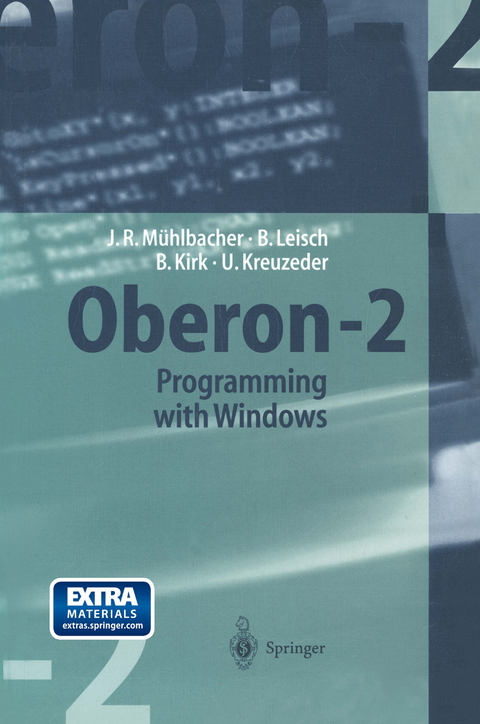
Oberon-2 Programming with Windows
Springer Berlin
978-3-540-62522-3 (ISBN)
Jörg R. Mühlbacher ist Professor für Informatik an der TNF der Johannes Kepler Universität Linz und lehrt dort Betriebssysteme, Computernetzwerke sowie Sicherheitsfragen in der Informatik. Er ist Autor von Büchern über Datenstrukturen, Programmierung sowie Grundlagen der Informatik
1. Introduction.- 2. First Steps.- 2.1 Installation of POW!.- 2.2 Operating the system.- 2.3 A first program.- 3. The Working Environment of POW!.- 3.1 Basic ideas.- 3.2 Editor.- 3.3 Project management.- 3.4 Templates.- 3.5 Button bar.- 3.6 Configuration.- 3.7 Working with windows.- 3.8 Tools.- 3.9 On-line help.- 3.10 Menu functions.- 3.11 Typical errors.- 3.12 Advanced topics.- 4. Introduction to Oberon-2.- 4.1 Introduction.- 4.2 Basics of a language.- 4.3 Basic language elements.- 4.4 Oberon-2 programs under POW!.- 4.5 Declarations.- 4.6 Statements.- 4.7 Expressions and assignments.- 4.8 Selection.- 4.9 Repeated execution (Iteration).- 4.10 Structured data types.- 4.11 Procedures.- 4.12 Modules.- 4.13 Pointer types.- 4.14 Recursion.- 4.15 Exercises.- 5. Object-Oriented Programming.- 5.1 Introduction.- 5.2 From abstract data types to classes.- 5.3 Concepts.- 5.4 Design.- 5.5 Application Examples.- 5.6 An object-oriented project.- 5.7 Retrospective and summary.- 5.8 Exercises.- 6. Oberon Portable Applications Library.- 6.1 What is a library?.- 6.2 Overview of the modules.- 6.3 Notes on the Windows implementation.- 6.4 The module ColorPlane.- 6.5 The module Display.- 6.6 The module File.- 6.7 The module Float.- 6.8 The module In.- 6.9 The module Out.- 6.10 The module Param.- 6.11 The module Print.- 6.12 The module Process.- 6.13 The module Strings.- 6.14 The module Utils.- 6.15 The module Volume.- 6.16 The module XYplane.- 7. Programming with the Windows API.- 7.1 Overview.- 7.2 Language extensions.- 7.3 Interfaces to "foreign" DLLs.- 7.4 Basic Windows program.- 7.5 The Mini-resource compiler.- Appendix A: Oberon-2 for Pascal programmers.- A.1 Constants.- A.2 Operators.- A.3 Data types.- A.4 Arrays.- A.5 Strings.- A.6 Open Arrays.- A.7 Pointer types.- A.8 Memorymanagement.- A.9 Compound data types.- A.10 Extensions of record types.- A.11 Procedure types.- A.12 Control structures.- A.13 Procedures.- A.14 Type-bound procedures.- A.15 Modules.- A.16 Export of identifiers.- A.17 Programs in Oberon-2.- A.18 Object-oriented programming.- Appendix B: The Programming Language Oberon-2.- B.1 Introduction.- B.2 Syntax.- B.3 Vocabulary and Representation.- B.4 Declarations and scope rules.- B.5 Constant declarations.- B.6 Type declarations.- B.7 Variable declarations.- B.8 Expressions.- B.9 Statements.- B.10 Procedure declarations.- B.11 Modules.- B.12 Definition of terms.- B.13 Syntax of Oberon-2.- B.14 The module SYSTEM.- B.15 Windows related language extensions.- Appendix C: Table of ASCII Codes.- Literature.
| Erscheint lt. Verlag | 20.6.1997 |
|---|---|
| Zusatzinfo | IX, 372 p. With CD-ROM. |
| Verlagsort | Berlin |
| Sprache | englisch |
| Maße | 155 x 235 mm |
| Gewicht | 596 g |
| Themenwelt | Mathematik / Informatik ► Informatik ► Betriebssysteme / Server |
| Schlagworte | Compiler • Design • Einführung in das Programmieren • HC/Informatik, EDV/Informatik • HC/Informatik, EDV/Programmiersprachen • Introduction to programming • language • Oberon • Oberon-2 • OBERON (Programmiersprache) • object-oriented programming • object-oriented programming (OOP) • Objektorientierte Programmierung • PASCAL • POW! • Programmieren unter Windows • programming • Programming language • Project Management • selection • Software • Strings • Templates • WINDOWS • Windows Programming |
| ISBN-10 | 3-540-62522-4 / 3540625224 |
| ISBN-13 | 978-3-540-62522-3 / 9783540625223 |
| Zustand | Neuware |
| Haben Sie eine Frage zum Produkt? |